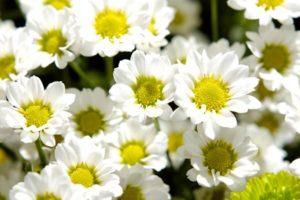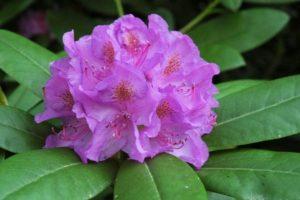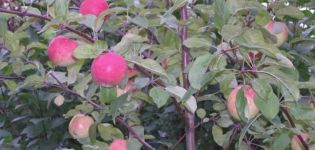Planting and caring for Iberis in the open field, a description of the best varieties
A miniature, abundantly flowering herb of the cabbage family - Iberis, is ubiquitous for growing in flower beds and alpine hills. Pepper is the second popular name for a flower. Caring for Iberis is simple, the plant is unpretentious, it is important to choose a site for a flower and plant it correctly. The flower is used in landscape design, as well as for cutting and decorating bouquets and flower arrangements.
Description and features
Under natural conditions, Iberis is found in Europe; in Russia, the plant can be found in the Crimea, the Caucasus, and the Krasnodar Territory. Main characteristics of the species:
- The root system is pivotal.
- Inflorescences are formed in the form of an umbrella.
- The fruit is a pod.
- The beginning of flowering depends on the variety - early May or August.
- Honey plant, pronounced fragrant aroma during the flowering period.
- There are perennial and annual species.
The Iberis community includes about 45 species of various herbs and shrubs. The color range is extensive, flowers come in various shades of white, lilac, pink.
Growing seedlings
A popular method of plant propagation is seedling. Seeds are harvested from mature plants after flowering or purchased from specialized stores. The seed is pre-prepared: disinfected in a solution of brilliant green or potassium permanganate, then planted in seedling boxes.
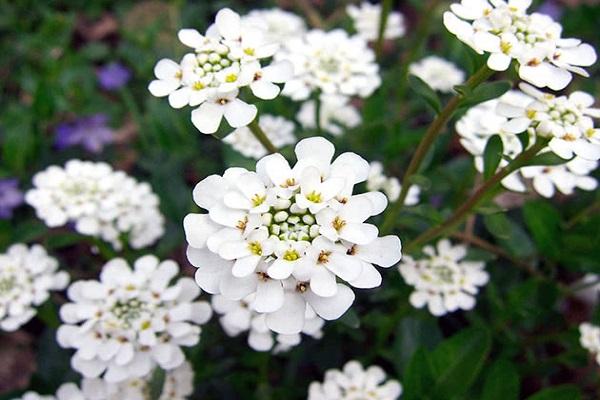
Timing
Iberis seedlings are sown in late February - early March. You should not sprinkle the seeds too much, a depth of 1-2 millimeters is enough, you can use sand.
After 7-10 days, the first sprouts appear, at the stage of three true leaves, the bushes dive and transplant into individual containers. Many gardeners do not make a pick, the root system of plants is very delicate, and does not tolerate the procedure well.
Soil preparation
The main requirement for the soil is its looseness. Loamy soil with the addition of sand and a small amount of peat is perfect. Iberis can grow in poor soils, but the plant should not lack moisture.Avoid overdrying the soil.
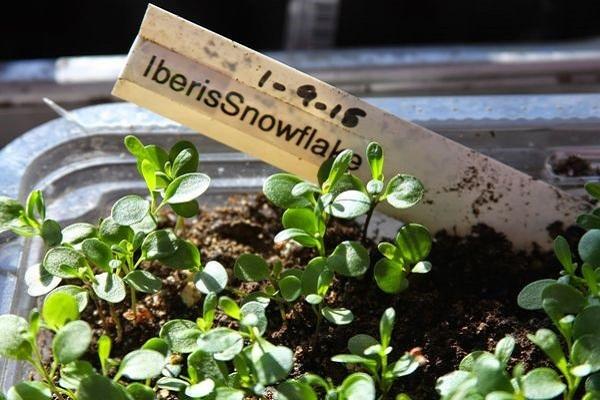
How to plant
In the seedling boxes on the prepared soil, grooves are drawn into which the seeds are carefully laid out. The spacing between plants should be at least 1 centimeter. After planting, the ground is watered, and the container is closed with a plastic bag and placed on a warm, well-lit windowsill.
Watering
It is necessary to irrigate future seedlings regularly using a spray bottle with warm water. To avoid high humidity inside the "greenhouse", small holes are made in polyethylene for ventilation.
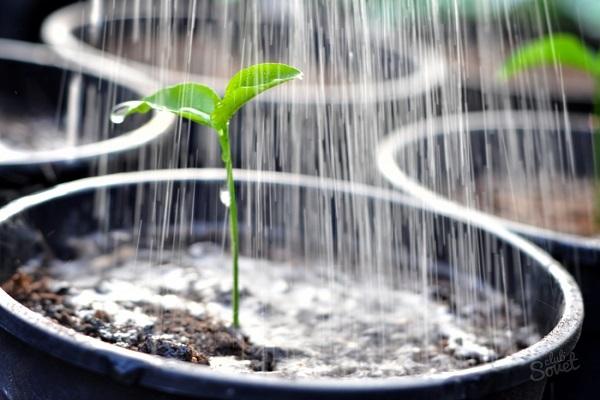
Landing in open ground
Iberis in open ground is planted with seedlings or directly by seeds in the soil. The timing of planting a herbaceous plant depends on the growing method.
When to plant
Seedlings are prepared for planting in unprotected soil in early - mid-May, the threat of night frosts must pass, and the soil temperature must be at least +10 FROM.
If the planting of plants is carried out with seeds directly into the open ground, then sowing can be carried out in mid-April, covering the beds for a while with a film or polycarbonate shelters.
Seat selection
The place for the Iberis should be sunny. The plant does not tolerate stagnant moisture at the roots, and does not withstand prolonged drought. Pepper pot can grow on the poorest soils of flower beds and rock gardens.

Soil requirements
The soil for a fragrant flower should be loose, loamy, with the addition of sand. Drainage is required. Soil acidity - neutral or with a slight alkaline reaction. Too acidic soil is lime.
Landing scheme
The interval between seedlings is maintained at 15-20 centimeters; for the purposes of landscape design, plantings are often thickened or, conversely, the distance is increased.
On a note: All actions with young plants are carried out with caution, Iberis has a delicate root system that is easy to damage during transplantation.
Care
Pepper is an unpretentious plant that does not need specialized care. Perfect for beginner growers. The basic rule of care is to avoid over-watering and frequent transplants.
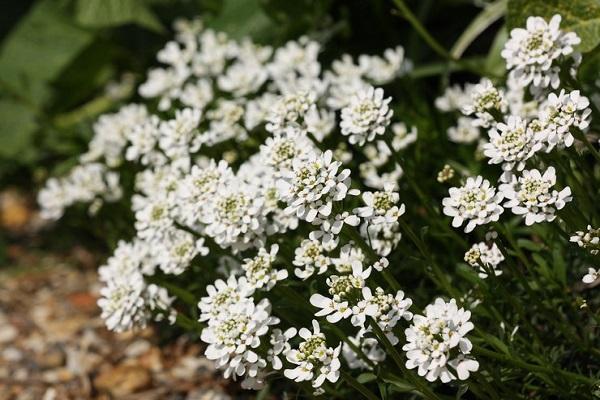
Watering
Iberis is a drought-resistant plant. In the summer, the plantings are watered during the period of prolonged heat. Irrigation is necessary in the morning or evening at the root.
Top dressing
A representative of the Cabbage family can grow on poor soils, does not need special fertilizers and regular feeding. It is enough to water the bushes twice a year (before flowering and immediately after it) with complex liquid mineral fertilizer.
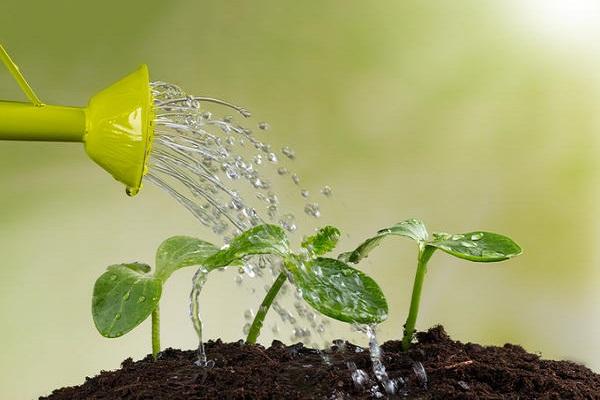
Pruning
Preventive pruning of leaves and dried stems is carried out in order to preserve the decorative appearance of the herbaceous bush. For the winter, perennial Iberises are cut off and the roots are covered with a layer of dry leaves.
Transfer
Perennials of Iberis can grow in one place for decades. The bush grows more and more every year. Frequent plant transplants are highly undesirable. The peppermint takes root in a new place for a long time, is sick. Never transplant during the flowering period.
After flowering
After the end of the flowering period, flower stalks and dried inflorescences must be removed from the plant. A second mineral dressing is introduced and the bush is spud. Even without flowers, the plant looks attractive in a flower bed or alpine slide.
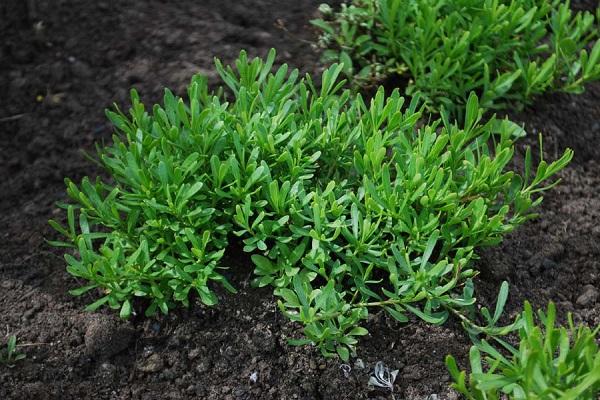
Preparing for winter
The root system of perennials is superficial, it needs protection from frost and winters with little snow. After the autumn pruning, the bush is sprinkled with a layer of dry leaves or closed for the winter. Although Iberises are declared as cold-resistant plants, they need to be taken care of for winter shelter.
Diseases and pests
Perennials immunity is resistant, perennials do not get sick with fungal diseases. The main threat is various insect pests.
Earthen fleas
The favorite prey of earthen fleas is young tender sprouts of Iberis. The pest attacks the plant immediately after germination. On the inside of the leaf plates, spots form, and on the outside, you can see a kind of light green paths.

Mealy worms
Insects of the order coccidi, popularly called hairy lice. They attack the leaves, stems of Iberis, feed on plant juices. A related species to scale insects. It actively reproduces and lives in conditions of increased dryness, is afraid of moisture.
Plants should be periodically inspected for larvae. You can remove them from the leaves by hand by cleaning with a cotton swab. “Aktara”, “Fitoverm”, “Iskra” are insecticides used against mealy worms and earthen fleas.
Aphid
A gluttonous pest that can completely destroy plants. The first sign of infection is leaf curling. Looking closer, you can see colonies of small insects. Often, aphids move to Iberis from diseased weeds. Insecticides are used to destroy the pest.
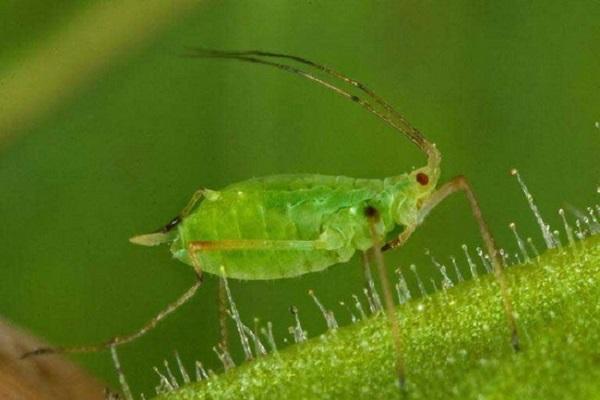
Fungus
Peppercorn is not susceptible to infection with fungal diseases, even if affected plants grow nearby.
Reproduction
A popular breeding method for Iberis is dividing the bush. Some gardeners grow seedlings from self-collected seeds. It is recommended to plant plants with seeds in the spring, the bush is divided in the fall.
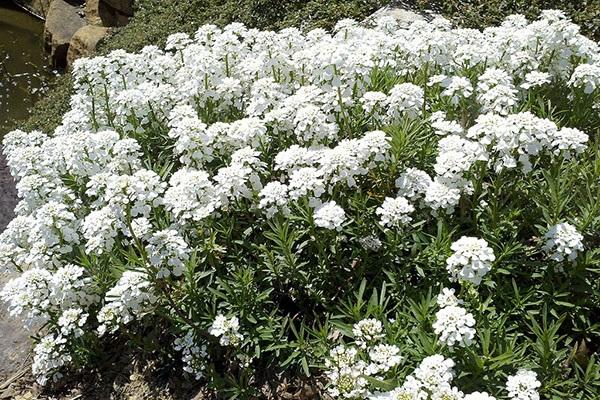
Collection and storage of seeds
For harvesting seeds after flowering, the flowering stems are not cut, but left to ripen. The peppers are a pod with small peas. When the fruit is ripe, it is cut and dried. The pods crack after a while, the seeds become easy to get.
Note: Store the harvested seed in a dry, dark place in a cloth or paper bag.
Dividing the bush
After the end of the flowering period or before it, perennial bushes are dug up and divided into 2-3 independent bushes. The best time for this breeding method is April or August-September.
The root system of the plant should be treated with special care, it is very fragile, and if damaged, the Iberis takes a long time to take root.
Cuttings
Iberis shoots released after flowering and pruning of the main flowering stems are best suited for cuttings. Cuttings are cut 10-15 centimeters long, put in a jar of water, as soon as roots and leaves appear, the cuttings are transplanted into a greenhouse or into a pot with earth. After about a month, the flower can be transplanted to a permanent place or left to winter in a greenhouse.
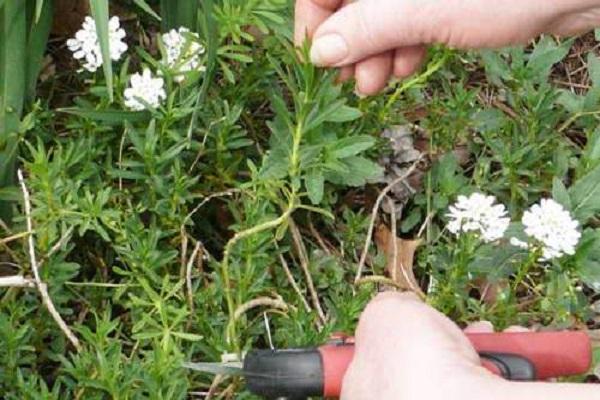
Kinds
In landscape design, various types of Iberis are used, on the basis of which various hybrid varieties are derived.
Bitter
Often mistaken for weeds. Annual. Distributed in the Caucasus and Krasnodar Territory. Iberis is popularly called village mustard. The height of the bush is 15 centimeters, it forms white umbellate inflorescences.
Umbrella
A beautiful ornamental herb. Used to create carpets, flower beds and alpine slides. It is presented in different color variations: white, pink, lilac.
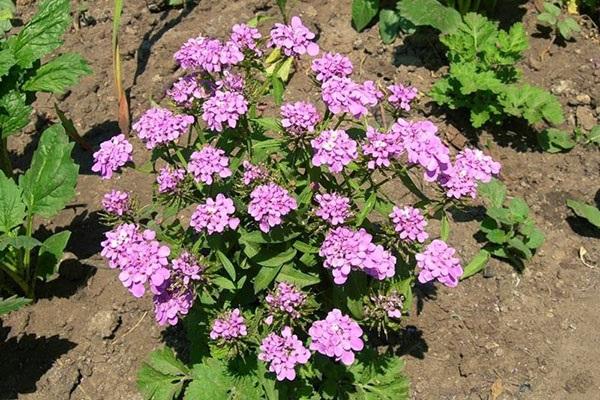
Gibraltar
Iberis-chameleon - gibraltar, during the flowering period changes color from white to purple. Forms flowering decorative pillows with a diameter of more than 30 centimeters. It is used in individual plantings and rock gardens.
Crimean
A miniature bush no more than 10 centimeters high, used to decorate rocky gardens. Grows on poor rocky soils. The color scheme is white and lilac.
Rocky
The height of the bush is 15 centimeters. Forms white umbellate inflorescences. Perfect for rock gardens. The superficial root system is quite fragile; plants must be transplanted with care.
Evergreen
The classic variety of Iberis. Height - 50 centimeters. During the flowering period, the umbrella inflorescences cover the bush completely. Shoots are erect, spreading. Requires decorative pruning after flowering.

Popular varieties
The range of Iberis varieties is quite extensive. To decorate flower beds and rock gardens, planting of various varieties is used simultaneously. This technique creates a color variety of similar shapes.
Red Flash
Representative of the umbrella species. The fragrant plant is a honey plant. Annual. Forms umbellate inflorescences of bright red color. A spectacular variety used to decorate rock gardens, used as a pot culture.
Fairy mixture
Forms a small herbaceous bush no more than 20 centimeters high. Dense inflorescences are collected in umbrellas. The color scheme is extensive and is represented by various pastel shades of pink and purple colors.
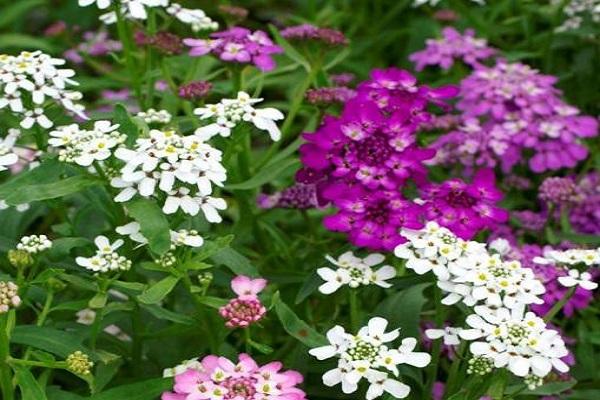
Tom Tumb
A variety of rocky Iberis, a low-growing herbaceous bush. Inflorescences of snow-white color, completely covering the plant. It is grown for decorative purposes in rock gardens.
Hyacinteblutige Riesen
Rocky view up to 40 centimeters high. It blooms in a bright purple color. Duration of flowering is 1.5 months. In landscape design, it is used as a curb plant, looks great in bouquets, can be grown in pots in indoor conditions.
Weiss Riesen
Bitter Iberis variety up to 30 centimeters high. Inflorescences are white, columnar, umbellate, 1.5 centimeters in diameter. The leaves are alternate, serrated. Flowering duration is 2 months.
Dana
A profusely flowering variety of evergreen pepper. The height of an adult plant is 15 centimeters. Inflorescences are umbrella-shaped, lilac. The fragrant plant is a honey plant.

Findall
A low-growing sprawling bush of evergreen peppers up to 30 centimeters high. Duration of flowering is 1 month. May bloom again in the last phase of summer.
Miniature flock
A popular dwarf variety of evergreen Iberis. Forms a small neat bush up to 15 centimeters high. Suitable for growing in rocky gardens. The inflorescences are white.
Blackberry meringue
A variety of umbrella Iberis. Suitable for cutting, the height of an adult plant is 40 centimeters. Inflorescences are formed rather large, more than 5 centimeters in diameter. Colors: from milky white to deep purple.
Iceberg
A fragrant variety of umbrella pepper. Honey plant. The height of an adult plant is 40 centimeters, suitable for decorating bouquets and flower arrangements. The inflorescences are white.
Candytaft
Iberis of Gibraltar, a chameleon flower, changes color from delicate lilac to deep purple during the flowering period. Looks spectacular in rock gardens and city flower beds.

Snowfall
A perennial variety of evergreen pepper. It grows to a height of no more than 20 centimeters. Flowers resemble snow-white snowflakes. It is used in individual plantings and rock gardens.
Medicinal properties and use in medicine
Peppermint is a medicinal plant in demand in folk medicine. Decoctions and tinctures from the roots, leaves and inflorescences of the plant are used:
- As a choleretic agent.
- In the treatment of gastritis and ulcers.
- As an antineoplastic agent.
- For quick healing and disinfection of wounds.
- Against gout.
- To relieve swelling and stimulate appetite.
When using folk remedies from Iberis, it is important to remember that the plant is poisonous. An allergic reaction or poisoning may occur if the dosage is not followed.
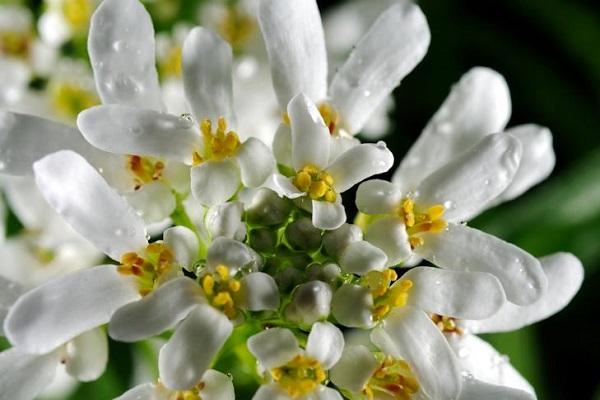
Use in landscape design
The evergreen herbaceous shrub is a favorite flower for gardeners for decorating rock gardens and framing flower beds and rocky gardens. The best combinations with Iberis:
- Various conifers.
- Hyacinths and daffodils.
- Creeping green plants.
- Bells and marigolds.
When decorating flower beds, various color variations and plant varieties are used.Pepper in combination with conifers emphasizes the elegance of rocky gardens. Ground cover plants and Iberis look perfect in rock gardens.
The peppermint is unpretentious and is able to quickly adapt to the vagaries of nature and changes in environmental conditions. The fragrant plant practically does not get sick, it is suitable for growing by novice gardeners.
